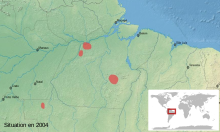Dendrobates castaneoticus
| Brazil-nut poison frog | |
|---|---|
 |
|
| Scientific classification | |
| Kingdom: | Animalia |
| Phylum: | Chordata |
| Class: | Amphibia |
| Order: | Anura |
| Family: | Dendrobatidae |
| Genus: | Adelphobates |
| Species: | A. castaneoticus |
| Binomial name | |
|
Adelphobates castaneoticus (Caldwell & Myers, 1990) |
|
 |
|
| Distribution of the Brazil-nut poison frog | |
| Synonyms | |
|
Dendrobates castaneoticus Caldwell and Myers, 1990 |
|
Dendrobates castaneoticus Caldwell and Myers, 1990
The Brazil-nut poison frog (Adelphobates castaneoticus) is a species of frog in the family Dendrobatidae. It is endemic to the state of Pará in Brazil. Its natural habitats are tropical moist lowland forests and intermittent freshwater marshes. It is threatened by habitat loss.
The frog is believed to have received its common name from the fact that its tadpoles sometimes develop in the hard capsules of the Brazil nut tree, which are common in its range. The nuts fall to the forest floor where they are broken open by agoutis and other animals seeking the seeds, and empty husks fill with water.
The Brazil-nut poison frog is a very small frog with a snout-to-vent length of 18 to 23 mm (0.7 to 0.9 in); females are usually larger than males. The dorsal surface is of a shiny black colour with spots and markings of white or various shades of yellow. There is a bright yellow or orange spot where the foreleg joins the body and two more similarly coloured spots on either side of the knee joint on the hind leg, which combine to make a single large spot when the animal is stationary. A further spot on the underside of the calf is only visible from below.
The Brazil-nut poison frog is endemic to the rainforest of central Brazil. It is known from several localities in the state of Pará; from Cachoeira Juruá, Xingu River, the type locality; from Taperinha some 300 km (186 mi) to the north west; and from Flona Tapajos, Santarém. These locations are some distance apart and it is likely that this frog has a more widespread distribution than is known but has passed undetected in other parts of its range. It lives among the leaf litter on the forest floor and sometimes climbs into low vegetation.
...
Wikipedia

